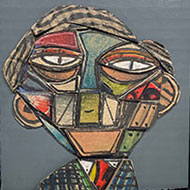In This Article
Illustrator career paths: job duties, education and more
Learn what draws people to become illustrators and where it can take them.

What is an illustrator?
Illustrators are visual artists, but their role as visual storytellers extends far beyond simply creating images that delight and inspire. Illustrators and their diverse set of skills are utilized by numerous different industries, and their applications are practically endless. A career as an illustrator, though always filled with creativity and artmaking, can take many different forms.
"An illustrator orchestrates visuals to tell a story, elicit a response, communicate a message, sell (or sell to), inform or educate an audience," wrote Michael Fleishman, an illustrator and author of eight books all about cultivating a successful career as an illustrator. "You could say that illustrators are militant visual problem solvers, schooled in advanced information technology, seeking to communicate organization (both pictorial and intellectual) or even advance chaos (both pictorial and intellectual)."
The goal of an illustrator is to elevate the text to create additional insight and meaning.
Illustrations, by their very definition, are usually paired with text and writing. The goal of an illustrator is to elevate the text to create additional insight and meaning.
"Illustrators interface aesthetics between type and image and are frequently at the core of graphic design that transcends the flat promise of a traditional 'good read.' Illustrators bob and weave with interactive and animated content for eager viewers (and readers) always hungry for something more (or at the very least, different) than a static page—or image—may offer," Fleishman said.
Like many artistic professions, the process of becoming an illustrator isn't as straightforward as some careers. In this guide, we'll discuss how to set yourself up for a career in illustration, what to expect as an illustrator, the different career paths you can follow and more.
What does an illustrator do?
Illustrators produce illustrations to communicate a message. The message may be inherently more artistic than others (such as the illustrations that you see in a children's book) or they may have a very specific goal like helping sell a product (such as a packaging design). Illustrators typically run their own business selling their services, or they may be employed by an individual company or a combination of the two.
In one of his books, Fleishman quotes illustrator Allan Wood who said, "Illustrators facilitate the creative process and collaborate with our clients to help manifest their ideals. We engage and communicate with our client's audience through visual language. In essence, we create cultural artifacts—no different from ancient Greek or Egyptian artifacts (the only difference is that our focus is not religion, but consumerism)."
As you can imagine, the possibilities of such are practically endless. Illustrators create pictures for books, magazines, blogs, e-zines and any number of types of publications. They create illustrations for commercial products and design textiles, greeting cards, wrapping paper and invitations. In today's digital world, illustrators can expect to use a computer to scan their creations into digital copies, or you may use graphic design software to make entirely digital works of art.
Illustrators use a variety of mediums to create their art, including ink, paint, watercolor, pencil and charcoal, collage, cardboard, mixed-media and so much more. You could even choose to work as a medical or scientific illustrator and create two and three-dimensional anatomical and molecular illustrations. You could create age-progression illustrations or work as a sketch artist for the criminal justice system.
It's important to note that your illustrator job description will include more than just creating artwork. You will also spend time doing the following:
- Communicating with customers
- Brainstorming and creating drafts of ideas
- Conducting research for design inspiration
- Creating a project timeline and meeting deadlines
- Refining designs and illustrations following client feedback
- Working with printers or others to ensure the quality of the final product
- Staying up to date with design trends and industry advancements
- Collaborating with other design professionals
A day in the life of an illustrator
The daily routine of an illustrator can be incredibly varied. Since many of illustrators are self-employed, a day in the life is going to include a lot of artmaking as well as tending to their business. If they are self-employed, illustrators can set their own hours and decide when and how much they work—provided deadlines and commitments to clients are met.
"There's no secret sauce of creativity or magic formula that conjures up the illustration process. Routines will develop and change as one advances and grows professionally and artistically. Some illustrators are night owls, some early birds. Probably a sleep-busting combination of both," Fleishman said. "I can just about guarantee that I could contact an illustrator buddy any hour of the day or night, especially as a deadline looms."
Although burning the midnight oil may be inevitable at times, Fleishman emphasized that taking care of your health is crucial to make your career a sustainable one.
"It is absolutely critical that you exercise (whether that is before, after, or in the middle of your studio time), eat regularly, and feed your soul in some way outside of the studio. Have a life outside of the studio."
Required skills and qualifications
There is no specific set of skills you must possess in order to qualify as an illustrator. Instead, your success hinges on a combination of several factors including your work ethic, artistic and business skills, ability to keep learning and, of course, a little luck.
That being said, perhaps the most important requisite to being an illustrator is having an innate desire to create for creation's sake.
"Illustrators at the top of the game inherently have a keen focus and a sense of the task (backed by a natural grasp of the rudiments). Most illustrators live with an obsession for the practice of illustration. Doing this just feels 'good' or 'right.' And at the core of it all, it's pure fun," Fleishman said.
Creative and technical skills
The foundation of a career in illustration—besides a passion for art—must be built upon an array of creative skills. In addition, today's increasingly digital world demands that illustrators adapt if they want to remain successful. Some of the creative and technical skills that illustrators should possess include:
- Artistic ability and creativity
- Excellent visualization and conceptualization skills
- Understanding of color theory and design principles
- Ability to work with different styles and mediums
- Proficiency in Adobe Creative Suite or other design software
- Ability to use graphic design tools and technologies
- Familiarity with printing processes and specifications
- Attention to detail
"Not to put too fine a point on it, but know how to draw, paint—whatever. Know how to fully use your tools (digital and/or traditional). Be fully conversant and eloquent with your media and methods. Be the best illustrator you can be. And revel in that. Notice I didn't say the best illustrator ever or the best illustrator there is. That's a trap (and more often than not, a self-imposed trap)," Fleishman said.
Soft skills and business acumen
Since a large portion of illustrators are self-employed, it's imperative that they have a grasp of the basics of running a business.
"Know how to run your business and stay in business. Buy the 'Graphic Artists Guild Handbook of Pricing and Ethical Guidelines' right away. If there is one, this is the Bible of being in business."
In addition, illustrators should be competent in the following to maximize their potential for success:
- Good communication skills
- Time management skills
- Ability to work in a team environment
- Openness to feedback and willingness to make changes
- Ability to take initiative and solve problems
- Understanding of marketing, particularly with social media
- Keeping up to date with industry developments and trends
"Social media marketing is critical. Know how to do it, which sites to use, how much time to spend on all this, how much money it will take. Work to build a following and a community. Deduce your target audience and who you want to illustrate for," Fleishman said.
As most artistic professionals can probably tell you, accepting rejection as a certainty is also important.
"Not being silly, but grow a thick skin," Fleishman said. "Here, Kelly White will tell you, 'Get used to people telling you (in no uncertain terms) that the drawing you just spent hours (or possibly days) on just isn't good enough. Or isn't what they wanted—even though you gave them exactly what they asked for.' Really, you can't take it personally. Also important: the presence of mind to explain what's needed and why; why this works when that does not."
Education and training to become an illustrator
It's true that a degree is not required to be a successful illustrator, but it sure can help. Illustration and other art degree programs can help lay the foundation to hone your skills. Since a lot of art degrees at the associate and bachelor's level require that you take classes working with lots of different mediums, a degree program can also expose you to what's out there and give you a chance to decide what mediums you prefer. Beyond majoring in illustration itself, illustrators may find it helpful to earn a degree in:
- Visual arts
- Graphic design
- Painting and drawing
- Photography and media
- Printmaking
- Interaction design
- Industrial design
- Visual communication design
"Go to school!" Fleishman said. "Saying that, traditional two-year and four-year colleges are not everyone's way to go, but that's another conversation."
Whether or not you decide to opt for a traditional degree program, there are lots of other ways to learn your craft, including:
- Individual courses and workshops, both in-person and online
- Internships and apprenticeships
- Continuing education courses and other professional development opportunities
"I'm repeating myself, but it bears repeating: master industry standard (and client-friendly) technology," Fleishman said. "Stay up to date on current trends—both traditional tools and media as well as hardware and software; follow blogs; listen to podcasts; join and participate in social media. Practice, practice, practice. Draw, draw, draw, and then draw some more."
Illustrator career paths
As an illustrator, you may find yourself working in a variety of industries. From working in criminal justice as a sketch artist to illustrating children's books, illustration is a highly flexible field that rewards those that can easily adapt to change.
Illustration is a highly flexible field that rewards those that can easily adapt to change.
Fleishman listed the following as just some examples of the types of illustration career paths you might consider pursuing:
- Book illustration
- Editorial illustration
- Reportage illustration (for the news and other journalistic sources)
- Photo illustration
- Packaging illustration
- Fashion and lifestyle illustration
- Greeting card illustration
- Retail product illustration
- Medical illustration
- Natural science illustration
- Technical illustration
- Architectural illustration
- 3-D illustration
- Magazine cartooning
- Editorial Cartoons
- Comic books
- Comic journalism
- Webcomics
- Graphic novels
- Surface and pattern design
- Animation
- Video games
- Motion graphics
- Software and Hardware products (packaging, ads, products, etc.)
Some of the types of employers that higher illustrators to create any of the above include:
- Design studios
- Advertising agencies
- Media design firms
- Movie studios
- Newspaper, magazine and book publishers (both online and print)
- Game design studios
Salary expectations for illustrators
According to the 2023 Occupational Employment and Wage Statistics from the U.S. Bureau of Labor Statistics (BLS), the median annual salary for fine artists, including painters, sculptors and illustrators is $59,300. It's important to bear in mind that a lot—if not most—professionals in this category are self-employed, which means their wages are not often reflected in data collected by the BLS. It's difficult, therefore, to say for certain what your earning potential can be as an illustrator.
Like most self-employed professionals, a higher salary typically comes with experience, testimonials from satisfied clients, word-of mouth and good marketing.
"It can take a while before you make any real money, so a solid support system that enables you to get up and keep running will be a good start," Fleishman said.
National data
Median Salary: $59,300
Projected job growth: 5.2%
10th Percentile: $28,390
25th Percentile: $38,160
75th Percentile: $88,690
90th Percentile: $135,420
Projected job growth: 5.2%
State data
| State | Median Salary | Bottom 10% | Top 10% |
|---|---|---|---|
| Arizona | $47,840 | $35,630 | $103,340 |
| California | $135,160 | $61,510 | $162,600 |
| Colorado | N/A | N/A | N/A |
| Connecticut | $66,160 | $42,540 | $101,480 |
| Florida | $47,170 | $37,240 | $105,730 |
| Georgia | $62,760 | $45,620 | $97,020 |
| Idaho | $59,010 | $31,870 | $101,820 |
| Illinois | N/A | N/A | N/A |
| Indiana | $54,490 | $36,520 | $93,220 |
| Iowa | N/A | N/A | N/A |
| Kansas | $38,580 | $20,730 | $84,790 |
| Kentucky | $29,370 | $22,450 | $52,000 |
| Louisiana | $26,520 | $24,640 | $42,600 |
| Maryland | $65,000 | $27,560 | $99,650 |
| Massachusetts | $80,950 | $32,050 | $139,000 |
| Michigan | $38,170 | $31,440 | $108,110 |
| Minnesota | $50,480 | $31,910 | $95,680 |
| Mississippi | $30,590 | $20,640 | $78,310 |
| Missouri | $24,960 | $24,960 | $63,720 |
| Montana | $36,670 | $20,700 | $56,130 |
| Nebraska | $41,180 | $24,700 | $70,050 |
| Nevada | $48,130 | $44,260 | $74,460 |
| New Hampshire | $35,570 | $30,430 | $54,810 |
| New Jersey | $67,480 | $47,860 | $112,780 |
| New Mexico | $41,600 | $29,120 | $127,810 |
| New York | $70,340 | $51,380 | $116,930 |
| North Carolina | N/A | N/A | N/A |
| North Dakota | N/A | N/A | N/A |
| Ohio | $45,100 | $21,560 | $70,990 |
| Oregon | $51,460 | $40,000 | $158,990 |
| Pennsylvania | $58,210 | $35,300 | $93,690 |
| South Carolina | $52,200 | $24,120 | $100,380 |
| Tennessee | $48,610 | $32,100 | $60,840 |
| Texas | $33,680 | $16,860 | $79,130 |
| Utah | $53,180 | $37,130 | $82,910 |
| Virginia | $62,300 | $37,150 | $83,950 |
| Washington | $63,810 | $37,480 | $98,170 |
| Wisconsin | $53,260 | $30,000 | $153,710 |
Source: U.S. Bureau of Labor Statistics (BLS) 2023 median salary; projected job growth through 2032. Actual salaries vary depending on location, level of education, years of experience, work environment, and other factors. Salaries may differ even more for those who are self-employed or work part time.
Final say
When you first think of an illustrator, someone who creates illustrations in children's books is probably the kind of person that comes to mind. While that is one career path you can take, a career in illustration can take practically an infinite number of forms, from creating illustrations for textbooks to graphic novels to video games and even product packaging.
If a career in illustration intrigues you, it may be worthwhile to explore illustration and similar degree programs to define and refine your skills. To learn more, consider checking out the Society of Illustrators for industry news and resources.
Updated: August 2, 2023

Written and reported by:
Kendall Upton
Staff Writer

Categories
Graphic Design Degree & Career Guide
- 4 Creative Ways to Use Your Graphic Design Degree
- 5 Graphic Design Portfolio Tips
- Advertising Degrees and You
- Advertising Design Job Description
- Advertising Designer Profile
- Careers in Computer-Aided Design
- Choosing Industrial Design Programs
- Education Initiatives Designed to Boost Enrollment in CAD Drafting School
- Graphic Design and Technology
- Graphic Design School and Career Guide
- Graphic Designer Job Outlook
- Graphic Designer Profile
- How to Get Ready for Graphic Design School
- Illustrator Career Paths: Job Duties, Education and More
- Industrial Design vs. Graphic Design
- Industrial Designer Job Description
- Industrial Designer Profile
- On-the-Job Graphic Design Training
